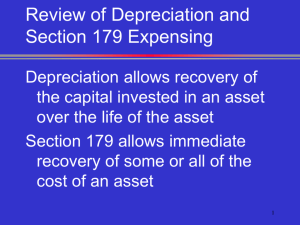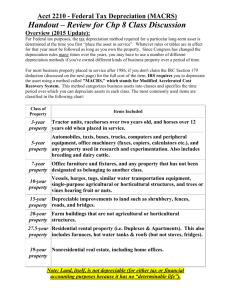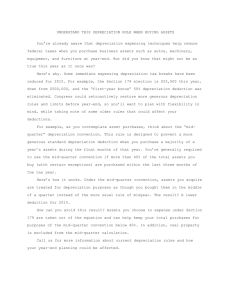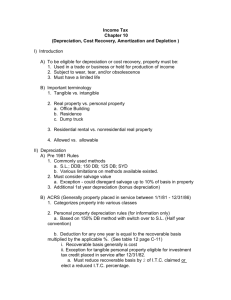Depreciation and Expensing Options ∗ Introduction
advertisement
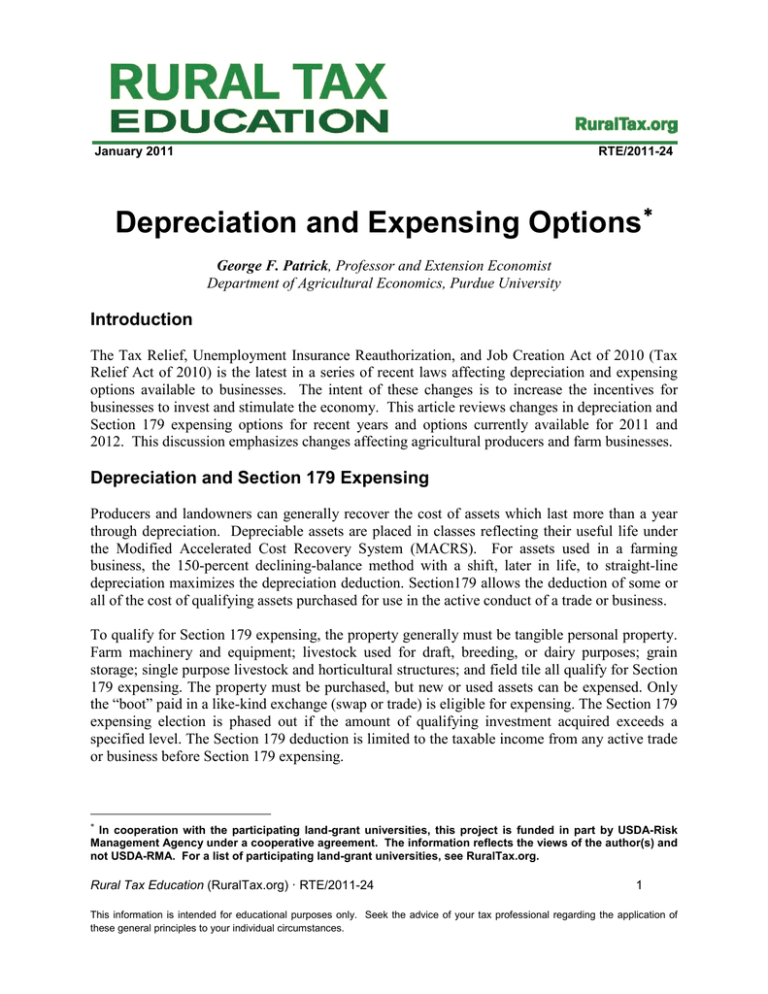
January 2011 RTE/2011-24 Depreciation and Expensing Options∗ George F. Patrick, Professor and Extension Economist Department of Agricultural Economics, Purdue University Introduction The Tax Relief, Unemployment Insurance Reauthorization, and Job Creation Act of 2010 (Tax Relief Act of 2010) is the latest in a series of recent laws affecting depreciation and expensing options available to businesses. The intent of these changes is to increase the incentives for businesses to invest and stimulate the economy. This article reviews changes in depreciation and Section 179 expensing options for recent years and options currently available for 2011 and 2012. This discussion emphasizes changes affecting agricultural producers and farm businesses. Depreciation and Section 179 Expensing Producers and landowners can generally recover the cost of assets which last more than a year through depreciation. Depreciable assets are placed in classes reflecting their useful life under the Modified Accelerated Cost Recovery System (MACRS). For assets used in a farming business, the 150-percent declining-balance method with a shift, later in life, to straight-line depreciation maximizes the depreciation deduction. Section179 allows the deduction of some or all of the cost of qualifying assets purchased for use in the active conduct of a trade or business. To qualify for Section 179 expensing, the property generally must be tangible personal property. Farm machinery and equipment; livestock used for draft, breeding, or dairy purposes; grain storage; single purpose livestock and horticultural structures; and field tile all qualify for Section 179 expensing. The property must be purchased, but new or used assets can be expensed. Only the “boot” paid in a like-kind exchange (swap or trade) is eligible for expensing. The Section 179 expensing election is phased out if the amount of qualifying investment acquired exceeds a specified level. The Section 179 deduction is limited to the taxable income from any active trade or business before Section 179 expensing. ∗ In cooperation with the participating land-grant universities, this project is funded in part by USDA-Risk Management Agency under a cooperative agreement. The information reflects the views of the author(s) and not USDA-RMA. For a list of participating land-grant universities, see RuralTax.org. Rural Tax Education (RuralTax.org) · RTE/2011-24 1 This information is intended for educational purposes only. Seek the advice of your tax professional regarding the application of these general principles to your individual circumstances. Note. Some states do not follow the federal Section 179 expensing rules on the state income tax return. These states typically have lower limits on the Section 179 election and deduction which they will allow. States have varying rules as to how to add back the excess Section 179 expensing taken on the federal income tax return. Additional First-Year or Bonus Depreciation The Economic Stimulus Act of 2008 provided for a “bonus” or additional first-year depreciation (AFYD) deduction equal to 50 percent of the adjusted basis of qualifying property placed in service after December 31, 2007 and before January 1, 2009. The 50 percent AFYD deduction was initially extended to qualified property placed in service before January 1, 2011 by the Creating Small Business Jobs Act of 2010. In December 2010, the Tax Relief Act of 2010 increased the first-year tax write-off to 100 percent for qualifying property placed in service after September 8, 2010 and before January 1, 2012. For property placed in service after December 31, 2011 and before January 1, 2013, the bonus depreciation or AFYD is currently scheduled to decrease to 50 percent. Property qualifying for AFYD must be new property with a MACRS recovery period of 20 years or less. Thus, agricultural machinery and equipment; work, breeding, and dairy livestock; singlepurpose agricultural and horticultural structures; field tile; and general purpose farm buildings, like machinery sheds, would be eligible. For qualifying assets acquired in a like-kind exchange, the entire basis (adjusted basis of the trade-in plus additional resources contributed) is eligible for AFYD. Cash rent and share lease landowners making qualified investments, such as field tile, are eligible for the AFYD, but not Section 179 expensing. Note. Some states do not follow the federal AFYD on the state income tax return. The federal presumption of the law is that taxpayers will use Section 168(k), AFYD. To not use AFYD, taxpayers must elect out on a class-by-class basis. Therefore, it may be necessary for some taxpayers who want their federal depreciation schedules to exactly match their state depreciation schedules to elect out of using AFYD. States have varying rules on how to add back the AFYD taken on the federal income tax return. Therefore, to use or elect out of AFYD requires thought and possibly input from the taxpayer’s tax advisor. Limitations The Economic Stimulus Act of 2008 also increased the maximum Section 179 deduction from $125,000 in 2007 to $250,000 in 2008. The 2007 Section 179 deduction is phased out if qualified investment exceeds $500,000. This investment threshold phase-out limit was increased to $800,000 in 2008. The Small Business Job Creation Act of 2010 further increased the maximum Section 179 deduction and investment limit to $500,000 and $2,000,000, respectively for tax years 2010 and 2011. For tax years beginning in 2012, the maximum Section 179 deduction will be $125,000 and the phase-out investment amount will be $500,000 (with indexing). The yearby-year limits are summarized in Figure 1. Rural Tax Education (RuralTax.org) · RTE/2011-24 2 This information is intended for educational purposes only. Seek the advice of your tax professional regarding the application of these general principles to your individual circumstances. Figure 1. Section 179 Expensing and Additional First-Year Depreciation for Producers Year Maximum Section 179 Deduction Section 179 Investment Limit Additional 1st Year Depreciation 2007 2008 2009 2010 2011 2012 $125,000 $250,000 $250,000 $500,000 $500,000 $125,000 $500,000 $800,000 $800,000 $2,000,000 $2,000,000 $500,000 100% 50% 50% 50% 50% before 9/9/10 100% after 9/8/10 Some Planning Considerations1 Some new assets, such as machinery sheds, shops, and general purpose buildings, are eligible for AFYD, but not Section 179 expensing. The entire adjusted basis of trade-in is eligible for AFYD, but only the boot portion is eligible for Section 179 expensing. AFYD is taken after the Section 179 expensing, if any. For AFYD, all qualifying assets in a MACRS class acquired during the tax year must be treated the same with respect to depreciation taken. In contrast, a producer can pick and choose with respect to how specific assets are treated for Section 179 expensing. The total acquisition of qualifying property may limit the amount of the Section 179 election. The allowable Section 179 deduction may be limited by taxable income from an active trade or business. Both Section 179 expensing and AFYD involve an acceleration of the cost recovery on selected assets. As noted previously, there are differences between methods and qualifying assets. Decisions can be made after the close of the tax year. Because of the retroactive nature of the 100 percent write-off to September 9, 2010, producers and landowners may need to reevaluate their 2010 year-end tax planning. Another consideration is that when using either Section 179 or AFYD to have larger deductions (or expenses) in the current tax year, this means that there are fewer deductions available in future years. A lower taxable income now from using Section 179 or AFYD may result in higher taxable incomes in future years. Differences between federal and individual state tax rules can further complicate tax planning and management. 1 For a more in-depth discussion of Section 179 and AFYD, see George Patrick, “Farmers’ Cost Recovery Alternatives for 2008.” Purdue Agricultural Economics Report, Nov. 2008, p. 7-10. http://www.agecon.purdue.edu/extension/pubs/paer/2008/November/PAER0811.pdf Rural Tax Education (RuralTax.org) · RTE/2011-24 3 This information is intended for educational purposes only. Seek the advice of your tax professional regarding the application of these general principles to your individual circumstances. Additional Topics This fact sheet was written as part of Rural Tax Education a national effort including Cooperative Extension programs at participating land grant universities to provide income tax education materials to farmers, ranchers, and other agricultural producers. For a list of universities involved, other fact sheets and additional information related to agricultural income tax please see RuralTax.org. This information is intended for educational purposes only. You are encouraged to seek the advice of your tax or legal advisor, or other authoritative sources, regarding the application of these general tax principles to your individual circumstances. Pursuant to Treasury Department (IRS) Circular 230 Regulations, any federal tax advice contained here is not intended or written to be used, and may not be used, for the purpose of avoiding tax-related penalties or promoting, marketing or recommending to another party any tax-related matters addressed herein. The land-grant universities involved in Rural Tax Education are affirmative action/equal opportunity institutions. Rural Tax Education (RuralTax.org) · RTE/2011-24 4 This information is intended for educational purposes only. Seek the advice of your tax professional regarding the application of these general principles to your individual circumstances.

